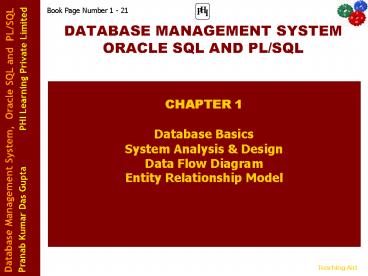DATABASE MANAGEMENT SYSTEM ORACLE SQL AND PL/SQL - PowerPoint PPT Presentation
1 / 20
Title:
DATABASE MANAGEMENT SYSTEM ORACLE SQL AND PL/SQL
Description:
White-box approach Page 15 - 17 CHAPTER 1 Short/Objective Type Questions 1 of 5 Teaching Aid Q13. ... 21] Page 17 - 21 Teaching Aid Database Management System, ... – PowerPoint PPT presentation
Number of Views:610
Avg rating:3.0/5.0
Title: DATABASE MANAGEMENT SYSTEM ORACLE SQL AND PL/SQL
1
DATABASE MANAGEMENT SYSTEM ORACLE SQL AND PL/SQL
Book Page Number 1 - 21
- CHAPTER 1
- Database Basics
- System Analysis Design
- Data Flow Diagram
- Entity Relationship Model
2
CHAPTER 1Database Basics 1 of 3
Page 1 - 5
- A database is a collection of interrelated data
stored together without harmful or unnecessary
redundancy - ADVANTAGES OF DATABASE
- Centralized management
- Sharing of Database
- Security
- DISADVANTAGES OF DATABASE
- Implementation Cost
- Maintenance Cost
3
CHAPTER 1Database Basics 2 of 3
Page 1 - 5
- CHARACTERISTICS OF DBMS
- Data Representation
- Performance
- Integrity
- Minimal Redundancy
- Privacy
- Security
4
CHAPTER 1Database Basics 3 of 3
Page 1 - 5
- DBMS ARCHITECTURE
- Internal Level
- Conceptual Level
- External Level
- DBMS MODELS
- Record Based Models Network, Hierarchical
Relational - Object Based Database Models
- Physical Data Model
5
CHAPTER 1 Software Development Life Cycle1 of 2
Page 5 - 8
- SDLC MODELS
- Waterfall
- Iterative Waterfall
- Prototype
- Evolutionary
6
CHAPTER 1 Software Development Life Cycle2 of 2
Page 5 - 8
- SDLC PHASES
- Feasibility Study
- System Analysis
- System Design
- Coding
- Testing
- Implementation
- Maintenance
7
CHAPTER 1Data Flow Diagram 1 of 4
Page 8 - 10
- Pictorial way of showing the flow of data into,
around and out of a system - MAJOR COMPONENTS
- Process
- Data Flow
- External Entity
- Data Stores
8
CHAPTER 1Data Flow Diagram 2 of 4
Page 8 - 10
9
CHAPTER 1Data Flow Diagram 3 of 4
Page 8 - 10
10
CHAPTER 1Data Flow Diagram 4 of 4
Page 8 - 10
11
CHAPTER 1Entity Relationship Model 1 of 4
Page 11 - 15
- ER Model is a high level database design
modelling technique. - ER Model use a set of construct and rules to
provide a precise representation of the data
content, structure, and constraints required by
an application.
12
CHAPTER 1Entity Relationship Model 2 of 4
Page 11 - 15
- CARDINALITY
- One to One Country and its capital
- One to Many State and cities
- Many to Many Parents and their children
13
CHAPTER 1Entity Relationship Model 3 of 4
Page 11 - 15
- EXTENDED
- ER MODEL COMPONENTS
14
CHAPTER 1Entity Relationship Model 4 of 4
Page 11 - 15
15
CHAPTER 1 Short/Objective Type Questions 1 of 5
Page 15 - 17
Q1. What is the role of security in DBMS? Q2.
What do you mean by maintenance of a
database? Q3. Briefly describe various types of
database models. Q4. Mention name of two customer
friendly SDLC modules. Q5. Which phase of SDLC
generates maximum revenue in the software
industry? Q6. Describe black box, white box,
alpha and beta level test strategies. Q7.
Describe four major components of data flow
diagram. Q8. Elaborate the terms aggregation,
generalization and specializations in E-R
model. Q9. How E-R module is represented in the
tabular form?
16
Page 15 - 17
CHAPTER 1 Short/Objective Type Questions 1 of 5
- Q10.The DFD of an application mainly shows
- a. Processing requirements and the flow of data
- b. Decision and control information
- c. Communication network structure
- d. Entity relationship model
- Q11. In an ER diagram ellipse represent
- a. Entity set
- b. Attributes
- c. Generalization
- d. Specialization
- Q12. ER modelling technique is a
- a. Bottom-up approach
- b. Black-box approach
- c. Top-down approach
- d. White-box approach
17
Page 15 - 17
CHAPTER 1 Short/Objective Type Questions 1 of 5
- Q13. Primary job of database administration
is/are - a. Backup
- b. Recovery
- c. Fine-tuning
- d. None of the above
- Q14. Low level data representation deals with
- a. Number of records
- b. Physical storage of data
- c. Logical representation of data
- d. None of the above
- Q15. Match the following w.r.t. DBMS
- a. Internal level a.
View level - b. External level b.
Physical level - c. Conceptual level c.
Logical level
18
Page 15 - 17
CHAPTER 1 Short/Objective Type Questions 1 of 5
- Q16. Record based model(s) is/are
- a. ER model
- b. Network model
- c. Hierarchical model
- d. Physical data model
- Q17. Number of phases in SDLC is
- a. 5
- b. 6
- c. 7
- d. 8
- Q18. In SDLC, DFD and ER model are part of
- a. Feasibility study
- b. System analysis
- c. System design
- d. System study
19
Page 15 - 17
CHAPTER 1 Short/Objective Type Questions 1 of 5
- Q19. In ER model, derived attribute is
represented by - a. Double rectangle
- b. Double diamond
- c. Dotted ellipse
- d. Dotted rectangle
- Q20. In ER model, degree of relationship is based
on - a. Number of attributes
- b. Number of entities
- c. Number of relations
- d. None of the above
20
CHAPTER 1 Home Assignment
Page 17 - 21
- WORKOUT SECTION
- Page 17 21































